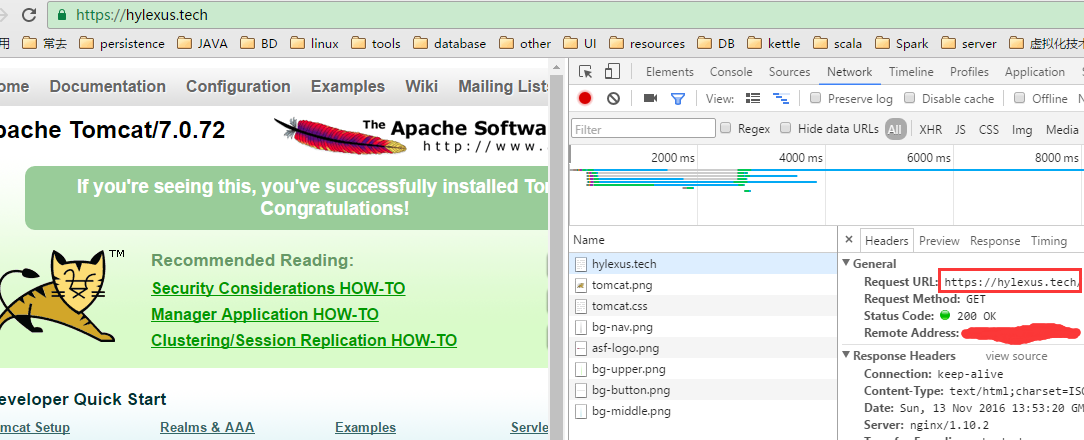前言
上一篇,我们介绍了nginx启用https,但是使用的证书是私有CA颁发的。
这种私有证书出来个人练习或者在内部使用外,还真不知道有什么其他用途。
现在,我们来体验体验真正的商用https证书。
1 环境准备
- 域名
- 本人这里是在阿里云买的域名
- 只要你想买的域名不是 google.com或在baidu.com这种白金次的话,一般都不贵吧……
- 域名备不备案在这里无所谓了
- 将域名解析到你自己的服务器
- 公网服务器
- 本人这里使用的是阿里云主机
- 得搞个公网主机,不然域名解析到哪里去呢?
- https证书
- 本人这里使用的是https://startssl.com/颁发的免费证书
- 确实不错,免费的
- 证书申请有疑问?请移驾:https://www.oschina.net/translate/switch-to-https-now-for-free?cmp
2 申请https证书
此处使用的是https://startssl.com/提供的免费https证书。
这部分有疑问的话,可以参考本人另一篇文章:http://blog.csdn.net/hylexus/article/details/53150333
# 本人申请证书后下载得到了一个hyl.xxx.tech.zip的压缩包
# 其中hyl.xxx.tech应该会用你自己的域名代替
# 该文件内容如下:
[root@hylexus https]# tree
.
├── ApacheServer.zip # apache/httpd
├── IISServer.zip # MS-IIS
├── NginxServer.zip # Nginx
└── OtherServer.zip # 其他服务器这里我们使用NginxServer.zip中的文件进行后续操作.
# 解压后得到文件:1_hyl.xxx.tech_bundle.crt
# 为方便后续操作,将该文件重命名为nginx.crt
# 并将其移动至nginx配置文件目录下新建的ssl目录下
mkdir /etc/nginx/ssl
# 证书文件nginx.crt
cp 1_hyl.xxx.tech_bundle.crt /etc/nginx/ssl/nginx.crt
# 应用程序秘钥nginx.key
# 名字随意,这个文件是你自己生成CSR的时候用的秘钥文件
cp nginx.key /etc/nginx/ssl/nginx.key3 nginx启用https
此时的ssl目录:
[root@hylexus ssl]# pwd
/etc/nginx/ssl
[root@hylexus ssl]# tree
.
├── nginx.crt # 申请的https证书
└── nginx.key # 应用程序私钥基于域名的虚拟主机配置
server{
# 同时支持http和https
listen 80;
listen 443 ssl;
server_name hyl.xxx.tech;
access_log /var/log/nginx/hyl.xxx.tech.access.log;
keepalive_timeout 70;
ssl_protocols TLSv1 TLSv1.1 TLSv1.2;
ssl_ciphers AES128-SHA:AES256-SHA:RC4-SHA:DES-CBC3-SHA:RC4-MD5;
ssl_certificate /etc/nginx/ssl/nginx.crt;
ssl_certificate_key /etc/nginx/ssl/nginx.key;
ssl_session_cache shared:SSL:10m;
ssl_session_timeout 10m;
location / {
#root /usr/share/nginx/html;
index dashboard index;
proxy_pass http://127.0.0.1:8080/;
proxy_set_header Host $http_host;
proxy_set_header X-Real-IP $remote_addr;
proxy_set_header X-Forwarded-For $proxy_add_x_forwarded_for;
proxy_set_header X-Forwarded-Proto $scheme;
}
}4 tomcat-server.xml配置
Connector等的配置按自己的喜好来
此处应该注意的地方是在你的虚拟主机下加一个 Valve
# 注意几个请求头和nginx虚拟主机的配置中应该是对应的
# X-Forwarded-For、X-Forwarded-Proto等
<Valve className="org.apache.catalina.valves.RemoteIpValve"
remoteIpHeader="X-Forwarded-For"
protocolHeader="X-Forwarded-Proto"
protocolHeaderHttpsValue="https"/>


























 2218
2218

 被折叠的 条评论
为什么被折叠?
被折叠的 条评论
为什么被折叠?








